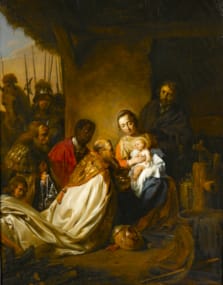
an de Bray
(Haarlem c.1627 - Haarlem 1697)
 Biography
Biography The Adoration of the Magi
Biography
Painter, draughtsman and etcher, Jan de Bray spent virtually the whole of his career in Haarlem, except for the period 1686–8, when he lived in Amsterdam. After training with his father Salomon de Bray (an architect and poet), Jan began working as a portrait painter in Haarlem in 1650, an activity he continued for the next 40 years. Between 1667 and 1684 he served on the committee for the Haarlem Guild of St. Luke, whose leading members he portrayed in a picture dated 1675 (Amsterdam, Rijksmuseum) that includes a self-portrait (Jan is seen standing and drawing on the left). He married three times, in 1668, 1670 and 1672. His first two wives died a year after their marriage, his third two years afterwards, and in each case the death was followed by disputes over the inheritance. Jan’s bankruptcy of 1689 may have been a result of one of the lawsuits. He was 62 at the time, and from then onwards he seems to have lost his artistic drive, crushed by the financial blow and the consequent loss of social status.
Jan de Bray was influenced by Van der Helst and Hals. De Bray's works are mainly portraits, often of groups. He specialised in posing specific figures as historical figures, thus achieving paintings that encompassed the genres of portrait and history painting. The French term for these, "portrait historié" (literally "historicised portrait") is also used in English, sometimes without the accent. Among his finest works are two versions of the Banquet of Cleopatra, using his own family, including himself, as models (Royal Collection, 1652, and Currier Museum of Art, New Hampshire, 1669). The second version has great pathos, as most of those depicted had died in the plague of 1663-4.
Collections
Jan de Bray is represented in the following collections: Fine Arts Museums of San Francisco; Hermitage Museum, St. Petersburg; Mauritshuis Royal Picture Gallery, The Hague; Museum of Fine Arts, Boston; National Galleries of Scotland, Edinburgh; National Gallery of Art, Washington D.C.; National Gallery, London; Rijksmuseum, Amsterdam; The Royal Collection, London; Courtauld Institute of Art, London; Frans Hals Museum, Haarlem; Harvard University Art Museums, Massachusetts, amongst others.









